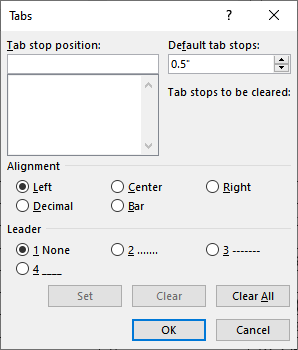Please Note: This article is written for users of the following Microsoft Word versions: 2007, 2010, 2013, 2016, 2019, 2021, and Word in Microsoft 365. If you are using an earlier version (Word 2003 or earlier), this tip may not work for you. For a version of this tip written specifically for earlier versions of Word, click here: Clearing All Tabs in a Document.
Written by Allen Wyatt (last updated May 4, 2024)
This tip applies to Word 2007, 2010, 2013, 2016, 2019, 2021, and Word in Microsoft 365
If you received a document from someone else, you may be charged with the responsibility to format the document. One of the first steps you may want to take is to remove all the tab stops in the document, thereby returning all paragraphs to their "pristine" state where only default tabs are in place.
If you want to remove all the tabs stops in a document, the quick way is to follow these steps:

Figure 1. The Tabs dialog box.
That's it. You can now go through the document, on a paragraph-by-paragraph basis, and set any tab stops desired.
One final thing: Remember that the above steps remove tab stops, not tab characters; they are different. Tab stops determine the horizontal location to which text following a tab character will be positioned. If you remove tab stops (again, following the steps above), then the tab characters remain in your document and will still affect horizontal positioning of any text that follows that tab character. If you want to remove tab characters, then you can use Find and Replace. Simply search for ^t (which is the tab character) and replace it with nothing or, if appropriate for your document, with a single space.
WordTips is your source for cost-effective Microsoft Word training. (Microsoft Word is the most popular word processing software in the world.) This tip (12073) applies to Microsoft Word 2007, 2010, 2013, 2016, 2019, 2021, and Word in Microsoft 365. You can find a version of this tip for the older menu interface of Word here: Clearing All Tabs in a Document.

Learning Made Easy! Quickly teach yourself how to format, publish, and share your content using Word 2021 or Microsoft 365. With Step by Step, you set the pace, building and practicing the skills you need, just when you need them! Check out Microsoft Word Step by Step today!
Tab stops allow you to modify the horizontal position at which text is positioned on a line. If you want to get rid of ...
Discover MoreWord allows you to use leader dots with your tab stops. If you want to space out the leader dots, you are limited in what ...
Discover MoreIf you don't explicitly set tab stops in a paragraph, Word relies upon a default tab stop distance. You can adjust that ...
Discover MoreFREE SERVICE: Get tips like this every week in WordTips, a free productivity newsletter. Enter your address and click "Subscribe."
There are currently no comments for this tip. (Be the first to leave your comment—just use the simple form above!)
Got a version of Word that uses the ribbon interface (Word 2007 or later)? This site is for you! If you use an earlier version of Word, visit our WordTips site focusing on the menu interface.
Visit the WordTips channel on YouTube
FREE SERVICE: Get tips like this every week in WordTips, a free productivity newsletter. Enter your address and click "Subscribe."
Copyright © 2026 Sharon Parq Associates, Inc.
Comments